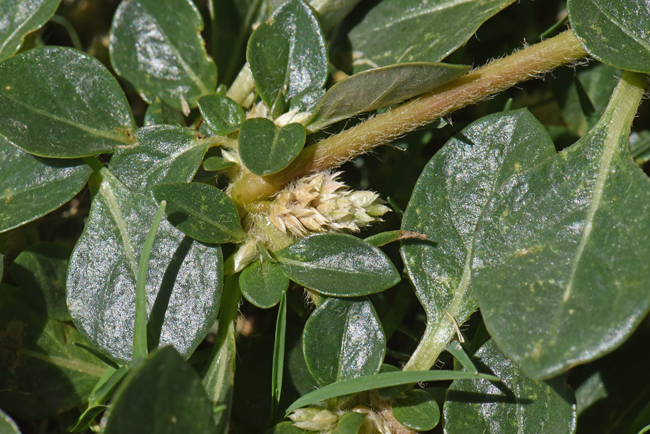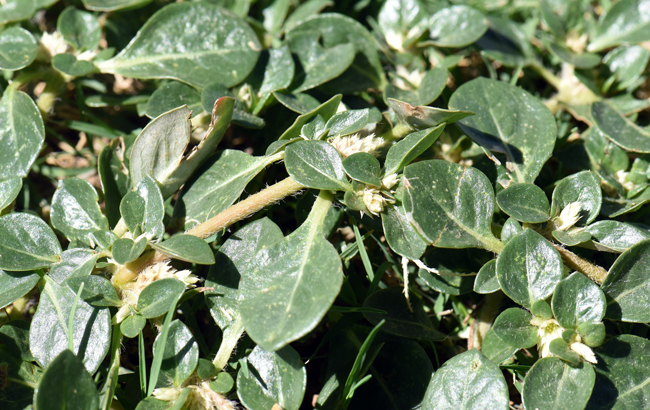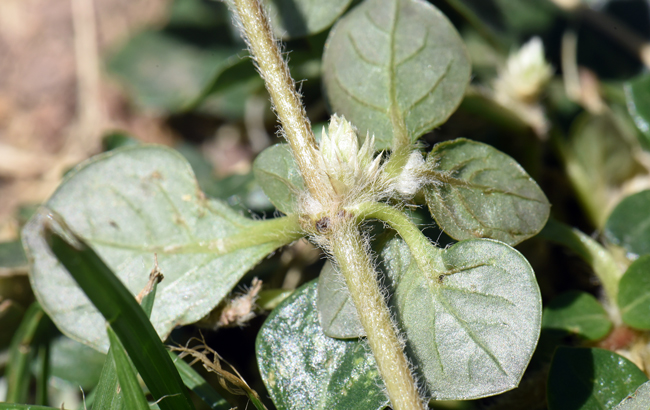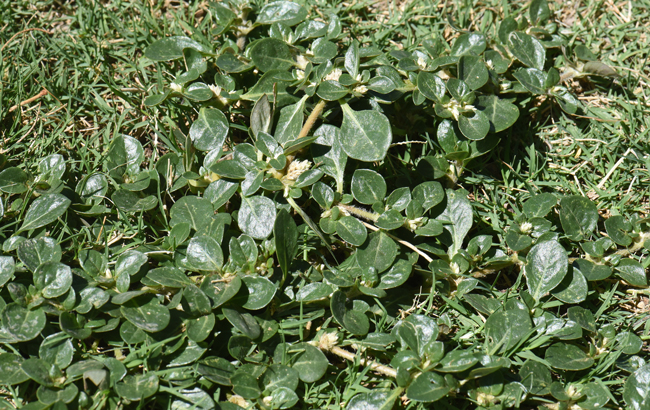Alternanthera pungens, Khakiweed





Scientific Name: Alternanthera pungens
Common Name: Khakiweed
Also Called: Alligatorweed, Creeping Chaffweed, Khaki-Weed
Family: Amaranthaceae, Pigweed Family
Synonyms: (Achyranthes leiantha, Achyranthes mucronata, Achyranthes radicans, Achyranthes repens, Alternanthera achyrantha, Alternanthera repens)
Status: Introduced - Central and South America, now widely established in Australia and Southern Africa.
Duration: Perennial
Size: 1 to 2.5 feet.
Growth Form: Forb/herb; forms dense mats; a creeping, prostrate to procumbent plant, stems villous, glabrescent; spreads by seed and vegetatively as roots develop from nodes at the spreading stem, the fleshy taproot keeps plants alive during periods of drought.
Leaves: Green; not always sessile, leaves elliptical to obovate; leaf surfaces pilose, glabrescent.
Flower Color: White with straw bracts; stramineous) or whitish; flowers axillary, flowers are lanceolate tepals; seeds ovate; fruit are stemless, prickly, papery, fruit is a one seeded utricle, stemless, khaki in color.
Flowering Season: Summer through fall. (May and June observed)
Elevation: Sea level to 5,000 feet.
Habitat Preferences: Lawns, waste grounds and limestone areas
Recorded Range: Khakiweed is an introduced species reported in AL, AZ, GA, LA, NY, SC, TX and VA. Herbarium records from SEINet report the species in SE AZ (Pima, Cochise, and Santa Cruz counties) are possibly that of Alternanthera repens (A. caracasana). It is native to South America.
North America & US County Distribution Map for Alternanthera pungens.
U.S. Weed Information: In North America Alternanthera pungens can be weedy or invasive according to the following authoritative sources: Weeds of the West, Western Society of Weed Science in cooperation with Cooperative Extension Services, University of Wyoming. Laramie, Wyoming. Plants included here may become weedy or invasive.
Invasive/Noxious Weed Information: In North America the genus Alternanthera is listed as a Noxious Weed by the State of Arkansas. Plants included here are invasive or noxious.
Wetland Indicator: No data available.
Threatened/Endangered Information: No data available.
Genus Information: In North America there are 15 species and 17 accepted taxa overall for Alternanthera; mostly in the southern parts of the United States and Mexico. 9 species introduced, 4 native. 2 introduced species in Arizona. Worldwide, The Plant List includes 137 accepted species names and a further 164 scientific names of infraspecific rank for Alternanthera.
In the Southwestern United States, Arizona has 3 species of Alternanthera, California has 1 species, Nevada has 0 species, New Mexico has 1 species, Texas has 7 species and Utah has 0 species. All data is approximate and subject to taxonomic changes.
Comments: Khaki Weed is an introduced species from Central and South America. It is now widely established in Australia and Southern Africa.
The specimens above were observed in a south Scottsdale public park growing in bare places and in Bermuda grass. At this time I do not believe this species is recognized as occurring in central Arizona and possibly in Arizona. In the states of record in which this species occurs, the USDA Plants Database does not include Arizona. However, the Flora of North America states that records indicate specimens of this species have been identified in the Herbarium at Arizona State University, Tempe, Arizona. If so, the specimens are possibly that of A. repens (=A. caracasana).
Alternanthera pungens was long known as Alternative repens and is suspected to have poisoned pigs and cattle that consumed it.
In Southwest Desert Flora also see a closely related species also called "Khaki Weed", Alternathera caracasana.
Khaki Weed is similar in appearance and habitat to another member of the Amaranth family, Small Matweed, Guilleminea densa, also an Amaranth found in Arizona.

